Formulation and Characterization of Niacinamide and Collagen Emulsion and Its Investigation as a Potential Cosmeceutical Product
Abstract
1. Introduction
2. Materials and Methods
2.1. Materials
2.2. Formulation and Preparation of Oil/Water (O/W) Emulsions
2.3. Calculation of Required Hydrophilic–Lipophilic Balance Values (rHLB) for the Prepared Emulsifiers
2.4. Characterization of O/W Emulsion
2.4.1. Physical Characterization, Stability, and pH
2.4.2. Determination of Water Content and Volatile Substances
2.4.3. Optical Microscopy Analysis
2.4.4. Contact Angle Evaluation
2.4.5. Rheological Analysis
2.4.6. Textural Analysis
2.4.7. Saponification Value
2.4.8. Microbiological Tests
Microbial Contamination Control
- Total aerobic microbial count (TAMC)
- Total combined yeasts and molds count (TYMC)
- Total aerobic microbial count (TAMC) = mean CFU determined on agar medium with casein and soy hydrolysate.
- Total combined yeasts and molds count (TYMC) = average CFU determined on the Sabouraud agar medium. If CFU bacteria are detected on this culture medium, they are taken into account in the total number of CFU developed on this medium.
Calculation of the Antibacterial Activity Ratio
Inhibitory Activity of Escherichia coli and Staphylococcus aureus Strains
- H = zone of inhibition, in millimeters;
- D = the total diameter of the halo of the inhibition zone, in millimeters;
- d = halo diameter, in millimeters.
3. Results and Discussion
3.1. Formulation of Oil/Water (O/W) Emulsions
3.2. Characterization of O/W Emulsion
3.2.1. Physical Characterization, Stability, and pH
3.2.2. Determination of Water Content and Volatile Substances
3.2.3. Optical Microscopy Analysis
3.2.4. Contact Angle Evaluation
3.2.5. Rheological Analysis
3.2.6. Textural Analysis
3.2.7. Saponification Value (SV)
3.2.8. Microbiological Tests
Microbial Contamination Control
Calculation of the Antibacterial Activity Ratio, R%
Inhibitory Activity of Escherichia coli and Staphylococcus aureus Strains
4. Conclusions
Author Contributions
Funding
Institutional Review Board Statement
Informed Consent Statement
Data Availability Statement
Conflicts of Interest
References
- Talianu, M.-T.; Dinu-Pîrvu, C.-E.; Ghica, M.V.; Anuta, V.; Jinga, V.; Popa, L. Foray into concepts of design and evaluation of microemulsions as a modern approach for topical applications in acne pathology. Nanomaterials 2020, 10, 2292. [Google Scholar] [CrossRef] [PubMed]
- Kligman, A. The future of cosmeceuticals: An interview with Albert Kligman, MD, Ph.D. Interview by Zoe Diana Draelos. Dermatol. Surg. 2005, 31, 890–891. [Google Scholar] [PubMed]
- Grace, R. Cosmeceuticals: Functional food for the skin. Nat. Foods Merch. 2002, 23, 92–99. [Google Scholar]
- Draelos, Z.D. The cosmeceutical realm. Clin. Dermatol. 2008, 26, 627–632. [Google Scholar] [CrossRef] [PubMed]
- Singhal, M.; Khanna, S.; Nasa, A. Cosmeceuticals for the skin: An overview. Asian J. Pharm. Clin. Res. 2011, 4, 6. [Google Scholar]
- Rodríguez, M.; Rodriguez, I.A.; Barrosso, L.G.R.; Sánchez, M.L. Collagen: A review on its sources and potential cosmetic applications. J. Cosmet. Dermatol. 2017, 17, 20–26. [Google Scholar] [CrossRef]
- Leon-Lopez, A.; Morales-Penaloza, A.; Martinez-Juarez, V.; Vergas-Torres, A.; Zeugolis, D.; Aguirre-Alvarez, G. Hydrolyzed collagen—Sources and applications. Molecules 2019, 24, 4031. [Google Scholar] [CrossRef]
- Bhagwat, P.; Dandge, P.B. Isolation, characterization and valorizable applications of fish scale collagen in food and agriculture industries. Biocatal. Agric. Biotechnol. 2016, 7, 234–240. [Google Scholar] [CrossRef]
- Loden, M. Role of topical emollients and moisturizers in the treatment of dry skin barrier disorders. Am. J. Clin. Dermatol. 2003, 4, 771–788. [Google Scholar] [CrossRef]
- Sionkowska, A.; Adamiak, K.; Musiał, K.; Gadomska, M. Collagen based materials in cosmetic applications: A Review. Materials 2020, 13, 4217. [Google Scholar] [CrossRef]
- Ghica, M.V.; Albu, M.G.; Kaya, D.A.; Popa, L.; Öztürk, Ş.; Rusu, L.-C.; Dinu-Pirvu, C.; Chelaru, C.; Albu, L.; Meghea, A.; et al. The effect of Lavandula essential oils on release of niflumic acid from collagen hydrolysates. Korean J. Chem. Eng. 2016, 33, 1325–1330. [Google Scholar] [CrossRef]
- Gensler, H.L. Prevention of photoimmunesuppression and photocarcinogenesis by topical niacinamide. Nutr. Cancer 1997, 29, 157–162. [Google Scholar] [CrossRef]
- Yu, J.M.; Liu, Y.; Xie, N.; Sun, W.; Wang, J.J.; Li, H.Q. Effects of nicotinamide on levels of dermis hydroxyproline in photoaging skin. Huanjing Yu Jiankang Zazhi J. Environ. Health 2002, 19, 102–104. [Google Scholar]
- Berk, M.A.; Lorincz, A.L. The treatment of bullous pemphigoid with tetracycline and niacinamide: A preliminary report. Arch. Dermatol. 1986, 122, 670–674. [Google Scholar] [CrossRef]
- Hakozaki, T.; Minwalla, L.; Zhuang, J.; Chhoa, M.; Matsubara, A.; Miyamoto, K.; Greatens, A.; Hillebrand, G.G.; Bissett, D.L.; Boissy, R.E. The effect of niacinamide on reducing cutaneous pigmentation and suppression of melanosome transfer. Br. J. Dermatol. 2002, 147, 22–33. [Google Scholar] [CrossRef]
- Trandafir, V.; Popescu, G.; Albu, M.G.; Iovu, H.; Georgescu, M. Collagen Extraction Techniques; Ars Docendi: Bucharest, Romania, 2007; Chapter 4; pp. 111–112. (In Romanian) [Google Scholar]
- Griffin, W.C. Classification of surface-active agents by “HLB”. J. Cosmet. Sci. 1949, 1, 311–326. [Google Scholar]
- STAS 10998-88; Emulsions and Cosmetic Creams. Methods of Analysis. The Romanian Standardization Institute: Bucharest, Romania, 2014.
- Anicescu, M.C.; Dinu-Pîrvu, C.E.; Talianu, M.T.; Ghica, M.V.; Anuța, V.; Prisada, R.M.; Nicoară, A.C.; Popa, L. Insights from a Box-Behnken Optimization Study of Microemulsions with Salicylic Acid for Acne Therapy. Pharmaceutics 2022, 14, 174. [Google Scholar] [CrossRef] [PubMed]
- Dănilă, E.; Albu Kaya, M.G.; Ghica, M.V.; Bunea, A.-M.; Popa, L.; Kaya, D.A.; Öztürk, Ş.; Marin, M.-M.; Dinu-Pîrvu, C.-E.; Anuța, V. Formulation and Characterization of Anti-Aging Cosmetic Emulsions Based on Collagen Hydrolysate and Caffeine. In Proceedings of the ICAMS 2020—8th International Conference on Advanced Materials and Systems, Bucharest, Romania, 1–3 October 2020; pp. 139–144. [Google Scholar]
- Tudoroiu, E.E.; Albu Kaya, M.G.; Titorencu, I.; Dinu-Pîrvu, C.E.; Marin, M.M.; Roșca, A.M.; Popa, L.; Anuța, V.; Antoniac, A.; Chelaru, C.; et al. Design and evaluation of new wound dressings based on collagen-cellulose derivatives. Mater. Des. 2023, 236, 112469. [Google Scholar] [CrossRef]
- Ghica, M.V.; Hirjau, M.; Lupuleasa, D.; Dinu-Pirvu, C. Flow and Thixotropic Parameters for Rheological Characterization of Hydrogels. Molecules 2016, 21, 786. [Google Scholar] [CrossRef]
- Szulc-Musioł, B.; Siemiradzka, W.; Dolińska, B. Formulation and evaluation of hydrogels based on sodium alginate and cellulose derivatives with quercetin for topical application. Appl. Sci. 2023, 13, 7826. [Google Scholar] [CrossRef]
- EN ISO 20743; Textiles—Determination of Antibacterial Activity of Antibacterial Finished Products. International Organization for Standardization: Geneva, Switzerland, 2007.
- Madaan, V.; Chanana, A.; Kumar, K.; Bilandia, M. Emulsion technology and recent trends in emulsion applications. Int. Res. J. Pharm. 2014, 5, 533–542. [Google Scholar] [CrossRef]
- Khan, A.Y.; Talegaonkar, S.; Iqbal, Z.; Jalees Ahmed, F.; Khar, R.K. Multiple emulsions: An overview. Curr. Drug Deliv. 2006, 3, 429–443. [Google Scholar] [CrossRef]
- Anghelache, A.M.; Kim, L.; Cuciureanu, A.; Batrinescu, G.; Pascu, L.F. Rheological properties and stability of squalene emulsion prepared with non-ionic emulsifier. Rev. Chim. 2017, 68, 1681–1684. [Google Scholar] [CrossRef]
- Dănilă, E.; Moldovan, Z.; Albu Kaya, M.G.; Ghica, M.V. Formulation and characterization of some oil in water cosmetic emulsions based on collagen hydrolysate and vegetable oils mixtures. Pure Appl. Chem. 2019, 91, 1493–1507. [Google Scholar] [CrossRef]
- Fares, M.M.; Radaydeh, S.K.; AlAmeen, H.M. Green Tannins/Avocado Oil Composites; Suncare and Skincare Materials. Arab. J. Chem. 2023, 16, 104764. [Google Scholar] [CrossRef]
- Ahmad, Z. The uses and properties of almond oil. Complement. Ther. Clin. Pract. 2010, 16, 10–12. [Google Scholar] [CrossRef]
- Colucci, G.; Santamaria-Echart, A.; Silva, S.C.; Fernandes, I.P.M.; Sipoli, C.C.; Barreiro, M.F. Development of water-in-oil emulsions as delivery vehicles and testing with a natural antimicrobial extract. Molecules 2020, 25, 2105. [Google Scholar] [CrossRef]
- Assaf, S.M.; Maaroof, K.T.; Altaani, B.M.; Ghareeb, M.M.; Abu Alhayyal, A.A. Jojoba oil-based microemulsion for transdermal drug delivery. Res. Pharm. Sci. 2021, 16, 326–340. [Google Scholar] [CrossRef] [PubMed]
- Choi, J.; Yang, D.; Moon, M.Y.; Han, G.Y.; Chang, M.S.; Cha, J. The protective effect of Hamamelis virginiana stem and leaf extract on fine dust-induced damage on human keratinocytes. Cosmetics 2021, 8, 119. [Google Scholar] [CrossRef]
- Available online: https://www.ellemental.com/859-limewater-tilia-vulgaris-organic.html (accessed on 17 October 2023).
- Smaoui, S.; Hlima, H.B.; Jarraya, R.; Grati Kamoun, N.; Ellouze, R.; Damak, M. Cosmetic emulsion from virgin olive oil: Formulation and biophysical evaluation. Afr. J. Biotechnol. 2012, 11, 9664. [Google Scholar]
- Wangpradit, N.; Macha, S.; Phooteh, N.; Yusohyo, N.; Waedoloh, A.; Manee, S. Determination of required hydrophilic-lipophilic balance of Amesiodendron chinense (Merr.) Hu oil and development of stable cream formulation. Oilseeds Fats 2022, 29, 8. [Google Scholar] [CrossRef]
- Krstonošić, V.; Dokić, L.; Nikolić, I.; Milanović, M. Influence of xanthan gum on oil-in-water emulsion characteristics stabilized by OSA starch. Food Hydrocoll. 2015, 45, 9–17. [Google Scholar] [CrossRef]
- Da Silva Santos, V.; Deschamps Fernandes, G. Chapter 37—Cold pressed avocado (Persea americana Mill.) oil. In Cold Pressed Oils: Green Technology, Bioactive Compounds, Functionality, and Applications; Ramadan, M.F., Ed.; Academic Press: London, UK, 2020; pp. 405–428. [Google Scholar]
- Ouzir, M.; El Bernoussi, S.; Tabyaoui, M.; Taghzouti, K. Almond oil: A comprehensive review of chemical composition, extraction methods, preservation conditions, potential health benefits, and safety. Compr. Rev. Food Sci. Food Saf. 2021, 20, 3344–3387. [Google Scholar] [CrossRef]
- Gad, H.A.; Roberts, A.; Hamzi, S.H.; Gad, H.A.; Touiss, I.; Altyar, A.E.; Kensara, O.A.; Ashour, M.L. Jojoba Oil: An Updated Comprehensive Review on Chemistry, Pharmaceutical Uses, and Toxicity. Polymers 2021, 13, 1711. [Google Scholar] [CrossRef]
- Femenia, A. High-value co-products from plant foods: Cosmetics and pharmaceuticals. In Handbook of Waste Management and Co-Product Recovery in Food Processing; Woodhead Publishing Limited: Cambridge, UK, 2007; Volume 1, pp. 470–501. [Google Scholar]
- De Oliveira, A.C.; Morocho-Jácome, A.L.; de Castro Lima, C.R.; Marques, G.A.; de Oliveira Bispo, M.; de Barros, A.B.; Costa, J.G.; de Almeida, T.S.; Rosado, C.; de Carvalho, J.C.; et al. Chapter 10—Cosmetics Applications. In Microalgae: Cultivation, Recovery of Compounds and Applications; Galanakis, C.M., Ed.; Academic Press: London, UK, 2020; pp. 313–332. [Google Scholar]
- Turcov, D.; Barna, A.S.; Blaga, A.C.; Ibanescu, C.; Danu, M.; Trifan, A.; Zbranca, A.; Suteu, D. Dermatocosmetic Emulsions Based on Resveratrol, Ferulic Acid and Saffron (Crocus sativus) Extract to Combat Skin Oxidative Stress-Trigger Factor of Some Potential Malignant Effects: Stability Studies and Rheological Properties. Pharmaceutics 2022, 14, 2376. [Google Scholar] [CrossRef] [PubMed]
- Dimitrova, T.D.; Leal-Calderon, F. Rheological properties of highly concentrated protein-stabilized emulsions. J. Colloid Interface Sci. 2004, 108, 49–61. [Google Scholar] [CrossRef] [PubMed]
- Kwak, M.-S.; Ahn, H.-J.; Song, K.-W. Rheological investigation of body cream and body lotion in actual application conditions. Korea Aust. Rheol. J. 2015, 27, 241–251. [Google Scholar] [CrossRef]
- Izidoro, D.R.; Scheer, A.d.P.; Sierakowsk, M.-R. Rheological properties of emulsions stabilized by green banana (Musa cavendishii) pulp fitted by power law model. Braz. Arch. Biol. Technol. 2009, 52, 1541–1553. [Google Scholar] [CrossRef]
- Zheng, T.; Tang, P.; Shen, L.; Bu, H.; Li, G. Rheological behavior of collagen/chitosan blended solutions. J. Appl. Polym. Sci. 2021, 138, 50840. [Google Scholar] [CrossRef]
- Amoo, L.M.; Layi Fagbenle, R. Overview of non-newtonian boundary layer flows and heat transfer. In Applications of Heat, Mass and Fluid Boundary Layers; Fagbenle, R.O., Amoo, O.M., Aliu, S., Falana, A., Eds.; Woodhead Publishing: Cambridge, UK, 2020; pp. 413–435. [Google Scholar]
- Dănilă, E.; Kaya, D.A.; Ghica, M.V.; Albu Kaya, M.G.; Negrea, C.; Popa, L.; Nitipir, C. Rheological properties and stability of dermatocosmetic emulsions with collagen and natural ingredients used as color correcting cream and cream foundation. Rev. Chim. 2019, 70, 1928–1933. [Google Scholar] [CrossRef]
- Zanna, N.; Tomasini, C. Peptide-based physical gels endowed with thixotropic behaviour. Gels 2017, 3, 39. [Google Scholar] [CrossRef] [PubMed]
- Tai, A.; Bianchini, R.; Jachowicz, J. Texture analysis of cosmetic/pharmaceutical raw materials and formulations. Int. J. Cosmet. Sci. 2014, 36, 291–304. [Google Scholar] [CrossRef] [PubMed]
- Tamburic, S.; Stevic, M.; Sisson, H. Rheological and texture analysis methods for the assessment of viscoelasticity. SOFW J. 2018, 144, 20–25. [Google Scholar]
- Nishinari, K.; Kohyama, K.; Kumagai, H.; Funami, T.; Bourne, M.C.J.F.S.; Research, T. Parameters of texture profile analysis. Food Sci. Technol. Res. 2013, 19, 519–521. [Google Scholar] [CrossRef]
- Poling-Skutvik, R.; Di, X.; Osuji, C.O. Correlation of droplet elasticity and volume fraction effects on emulsion dynamics. Soft Matter 2020, 16, 2574–2580. [Google Scholar] [CrossRef]
- STAS 1445; Fats and Oils of Animal and Vegetable Origin. Determination of the Saponification Index. The Romanian Standardization Institute: Bucharest, Romania, 1998.
- Ivanova, M.; Hanganu, A.; Dumitriu, R.; Tociu, M.; Ivanov, G.; Stavarache, C.; Popescu, L.; Ghendov-Mosanu, A.; Sturza, R.; Deleanu, C.; et al. Saponification value of fats and oils as determined from H-NMR data: The case of dairy fats. Foods 2022, 11, 1466. [Google Scholar] [CrossRef]
- Douati, T.E.; Konan N’Guessan, Y.; Coulibaly, A.; Sidibe, D.; Biego Godi, H.M. Nutritive components in the Terminalia catappa L. Combretaceae) almonds cultivated in côte d’ivoire. J. Appl. Life Sci. Int. 2017, 12, 1–10. [Google Scholar]
- Flores, M.; Saravia, C.; Vergara, C.E.; Avila, F.; Valdés, H.; Ortiz-Viedma, J. Avocado oil: Characteristics, properties, and applications. Molecules 2019, 24, 2172. [Google Scholar] [CrossRef]
- Busson-Breysse, J.; Farines, M.; Soulier, J. Jojoba wax: Its esters and some of its minor components. J. Am. Oil Chem. Soc. 1994, 71, 999–1002. [Google Scholar] [CrossRef]
- Zielińska, A.; Nowak, I. Fatty acids in vegetable oils and their importance in cosmetic industry. Chemik 2014, 68, 103–110. [Google Scholar]
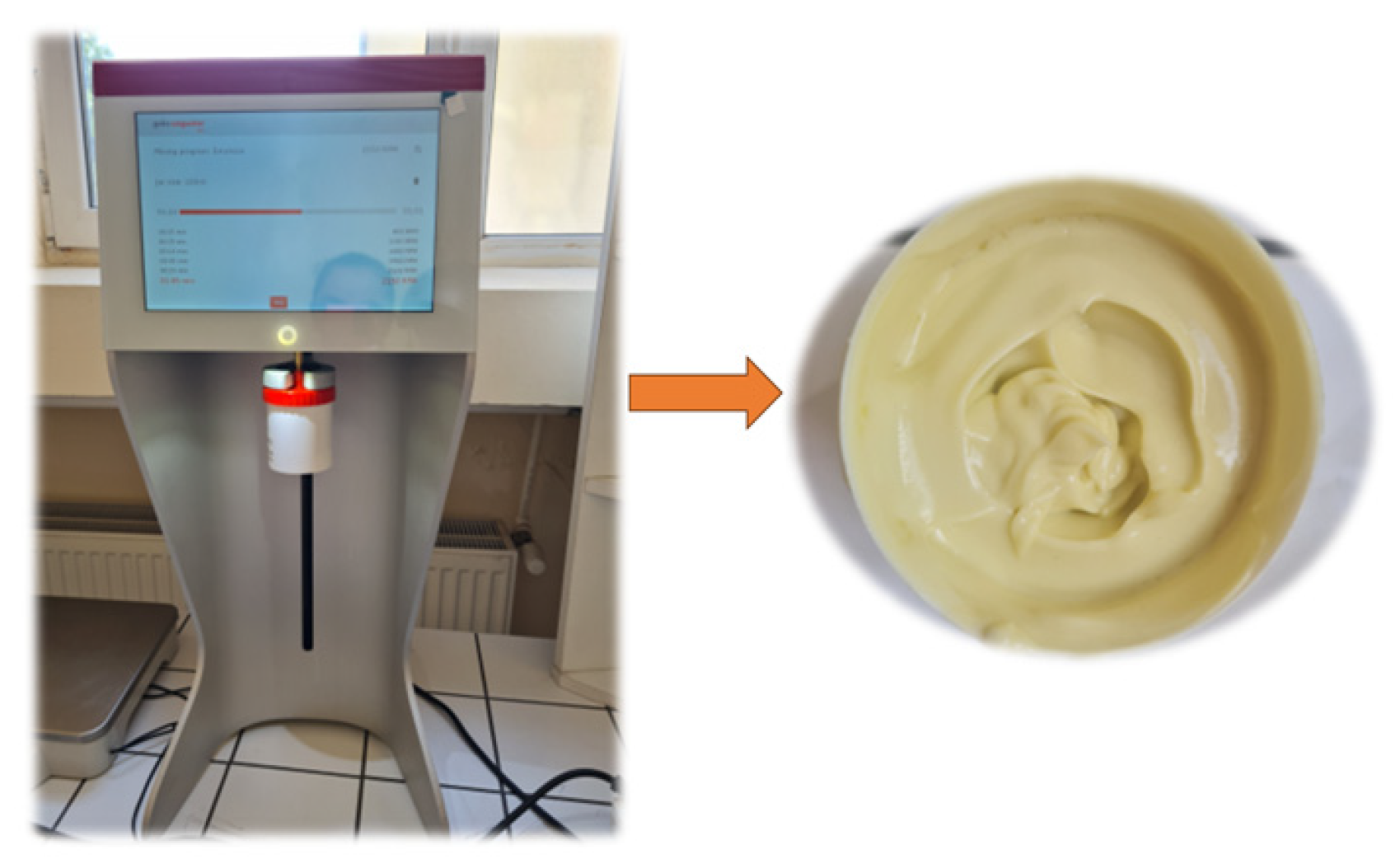
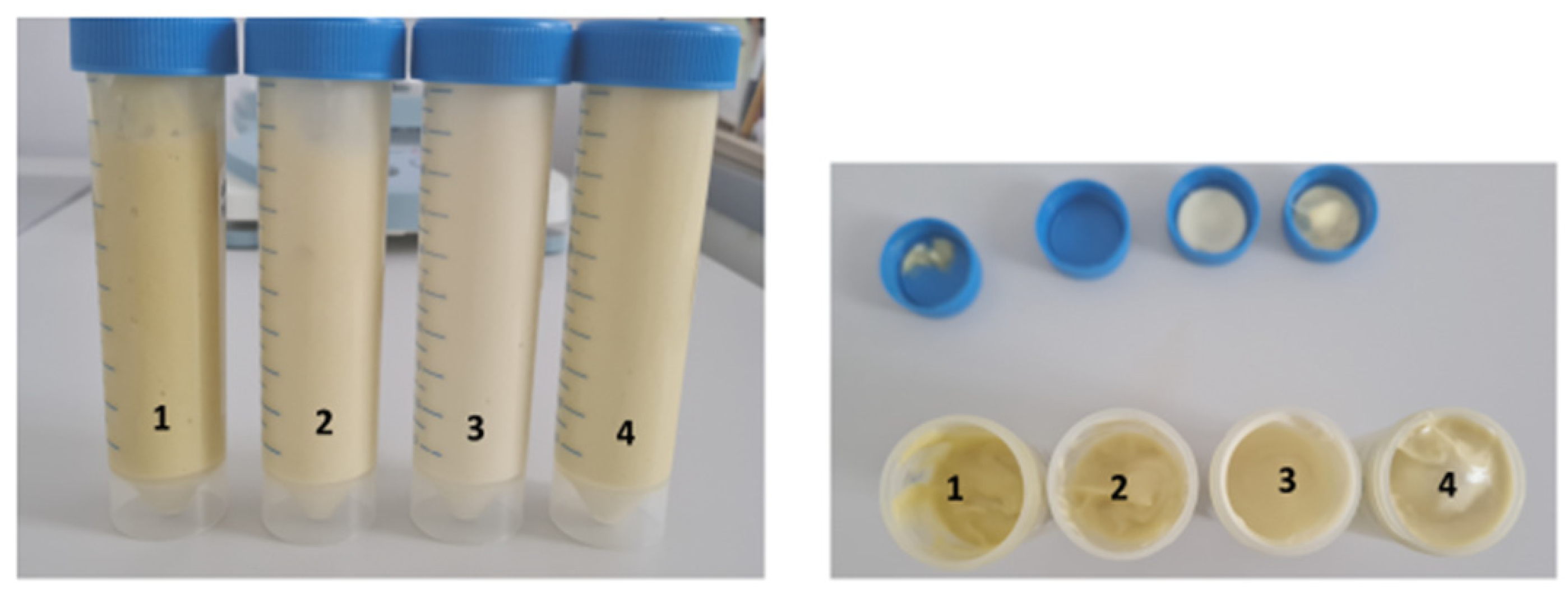

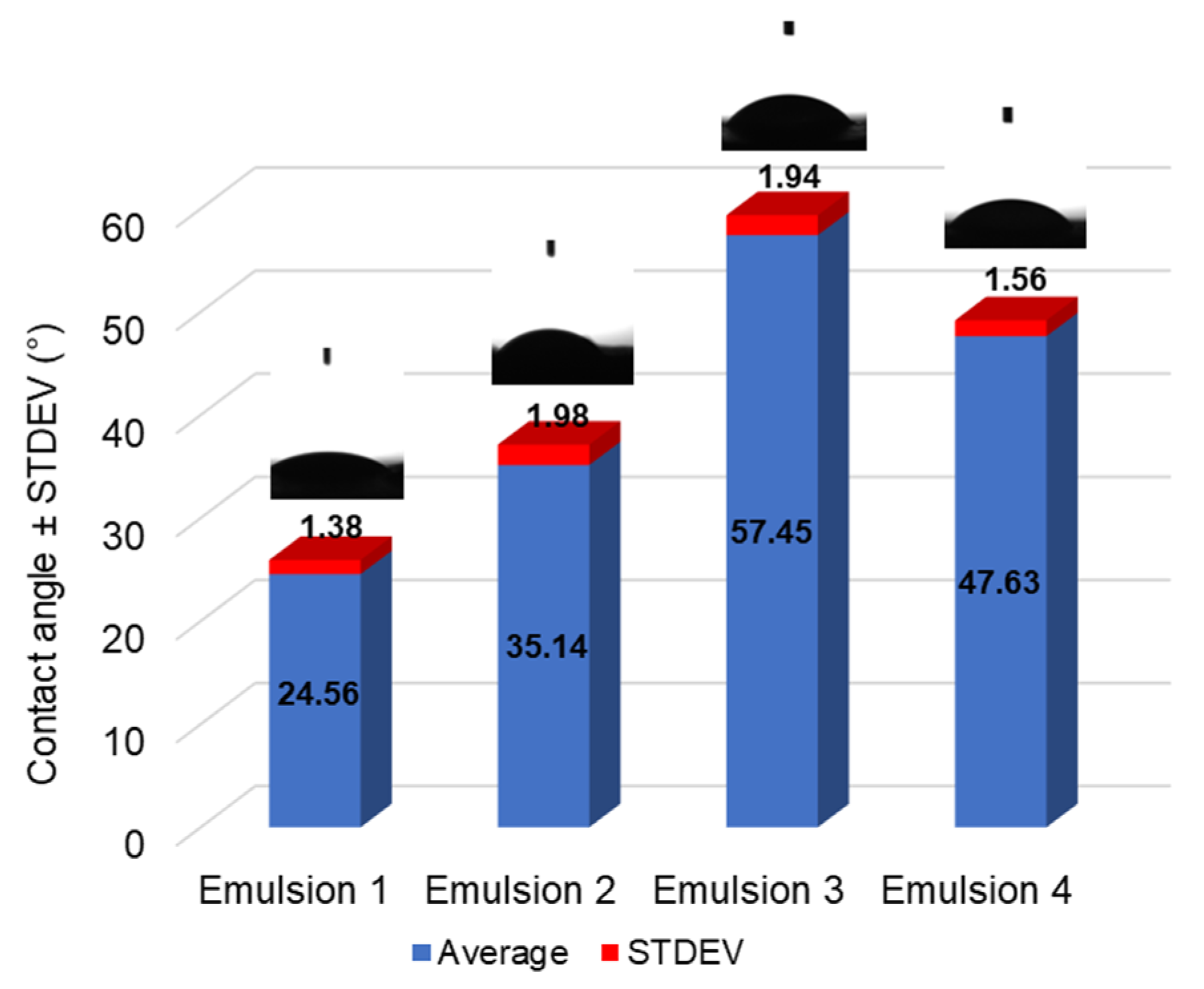
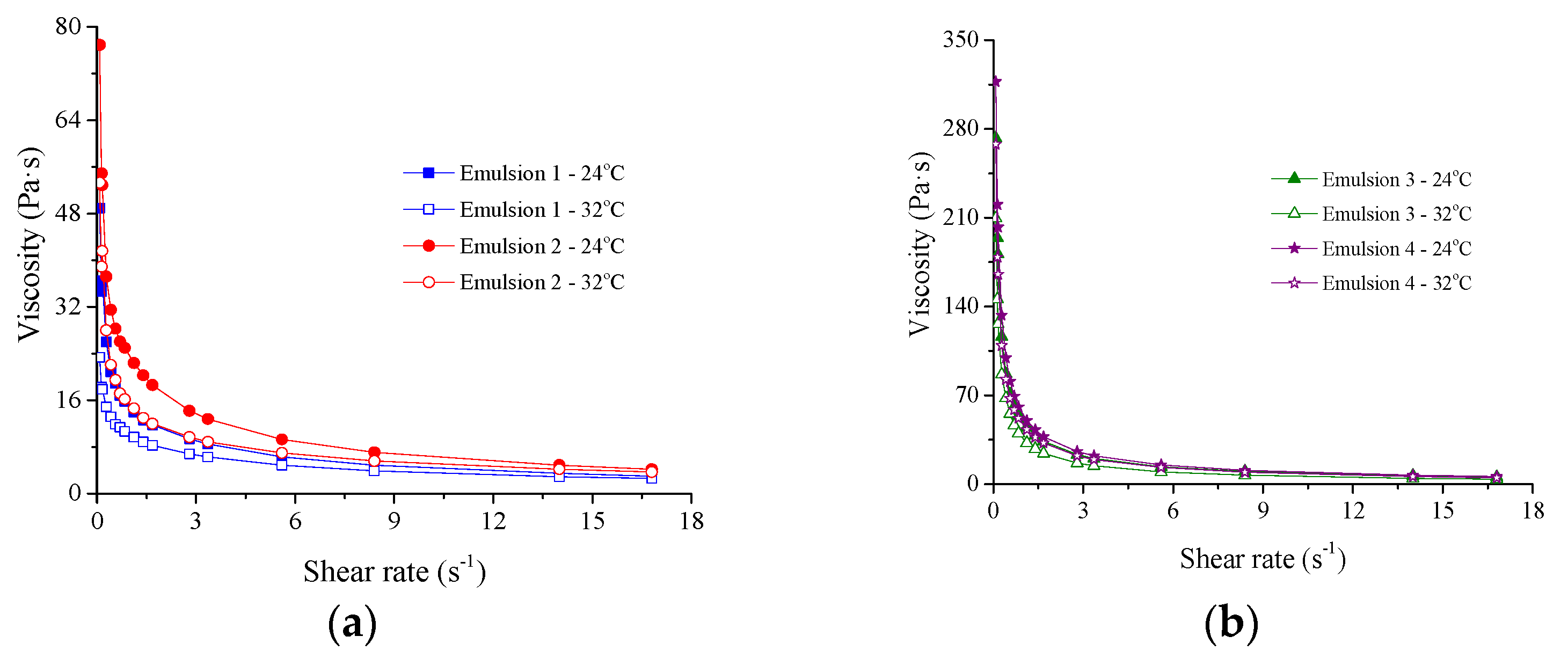
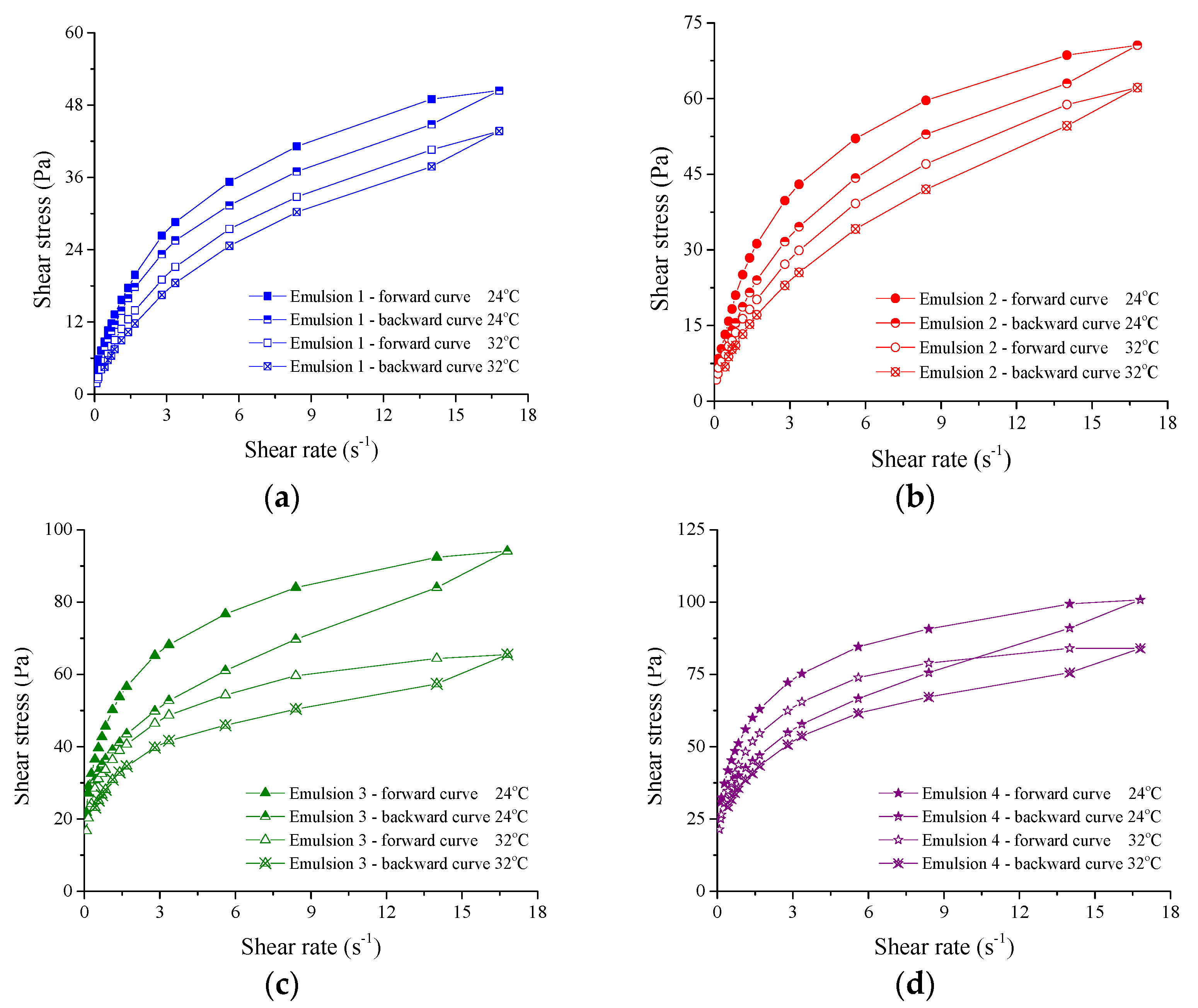


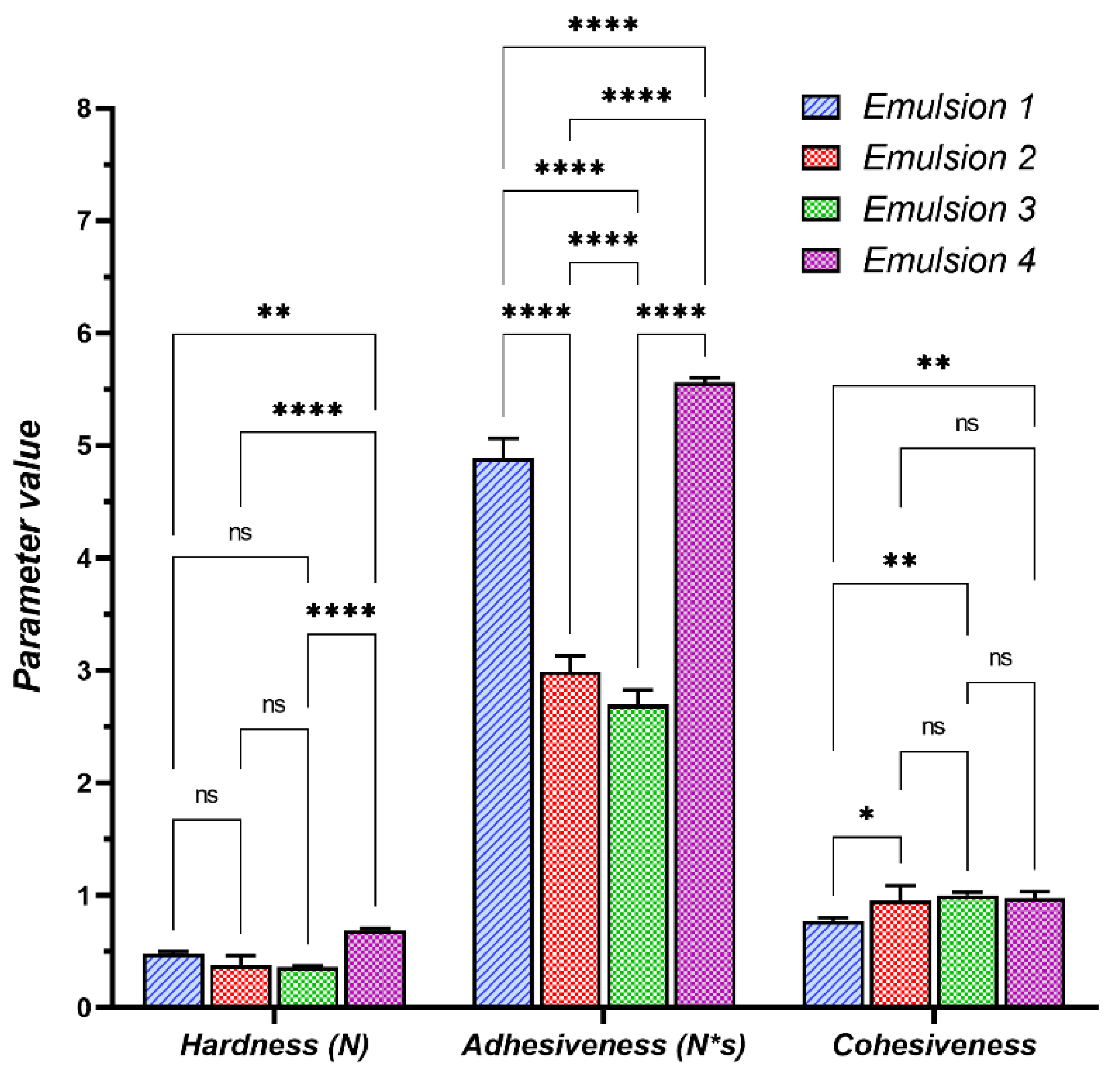
| Phase | Ingredient Common Name | Ingredient INCI Name *** | Percentage by Weight, % | |||
|---|---|---|---|---|---|---|
| Emulsion 1 | Emulsion 2 | Emulsion 3 | Emulsion 4 | |||
| A | Avocado oil (mL) | Persea gratissima oil | 30 | 20.9 | 10.7 | 30 |
| A | Almond oil (mL) | Prunus amygdalus Dulcis oil | 10 | 10 | - | - |
| A | Jojoba oil (mL) | Simmondsia chinensis oil | - | - | 10 | 10.5 |
| A | Emulsifiant Bella (g) * | Glyceryl stearate | 5 | 5 | 5 | 5 |
| B | Floral water (mL) ** | Hamamelis virginiana/Tilia vulgaris water | 11 | 10 | 9 | 20 |
| B | Distilled water (mL) | Aqua | 40 | 50 | 60 | 30 |
| B | Hydrolyzed collagen (g) | Hydrolyzed collagen | 1 | 1.5 | 2 | 2 |
| B | Niacinamide (g) | Niacinamide | 1 | 1.5 | 2 | 1 |
| C | Xanthan gum (g) | Xanthan gum | - | 0.1 | 0.3 | 0.5 |
| C | Cosgard preservative (mL) | benzyl alcohol, salicylic acid, glycerin, ascorbic acid | 0.5 | 0.5 | 0.5 | 0.5 |
| D | Pinus brutia essential oil (mL) | Pinus brutia essential oil | 0.5 | 0.5 | 0.5 | 0.5 |
| Emulsion No. | Emulsion 1 | Emulsion 2 | Emulsion 3 | Emulsion 4 |
|---|---|---|---|---|
| pH of fresh samples | 5.75 ± 0.21 | 5.12 ± 0.23 | 5.10 ± 0.35 | 5.81 ± 0.32 |
| pH after 30 days | 5.61 ± 0.23 | 5.23 ± 0.33 | 5.21 ± 0.31 | 6.02 ± 0.34 |
| Emulsion No. | Ratio, w/w AVC:ALM:JOJ:B * | rHLB of the Emulsifier Blend |
|---|---|---|
| Emulsion 1 | 30:10:0:6 | 6.63 |
| Emulsion 2 | 20.9:10:0:5 | 6.55 |
| Emulsion 3 | 10.7:0:10:5 | 6.77 |
| Emulsion 4 | 30:0:10.5:5 | 6.87 |
| Emulsion No. | Emulsion 1 | Emulsion 2 | Emulsion 3 | Emulsion 4 |
|---|---|---|---|---|
| m (g) | 1.82 | 1.08 | 1.18 | 1.11 |
| m1 (g) | 11.22 | 10.35 | 10.35 | 10.28 |
| m2 (g) | 11.34 | 10.56 | 10.69 | 10.59 |
| water content and volatile substance, % | 6.59 | 19.44 | 28.81 | 27.93 |
| Emulsion | m | n | R2 | |||
|---|---|---|---|---|---|---|
| Forward Curve | Backward Curve | Forward Curve | Backward Curve | Forward Curve | Backward Curve | |
| Emulsion 1 | 14.355 | 12.808 | 0.480 | 0.462 | 0.9952 | 0.9950 |
| Emulsion 2 | 21.746 | 17.189 | 0.487 | 0.442 | 0.9937 | 0.9946 |
| Emulsion 3 | 48.827 | 38.401 | 0.689 | 0.741 | 0.9983 | 0.9996 |
| Emulsion 4 | 54.553 | 42.408 | 0.702 | 0.762 | 0.9994 | 0.9993 |
| Emulsion | m | n | R2 | |||
|---|---|---|---|---|---|---|
| Forward Curve | Backward Curve | Forward Curve | Backward Curve | Forward Curve | Backward Curve | |
| Emulsion 1 | 9.565 | 8.188 | 0.351 | 0.362 | 0.9923 | 0.9914 |
| Emulsion 2 | 15.172 | 12.253 | 0.499 | 0.397 | 0.9933 | 0.9918 |
| Emulsion 3 | 35.771 | 29.589 | 0.701 | 0.719 | 0.9992 | 0.9997 |
| Emulsion 4 | 45.306 | 37.549 | 0.703 | 0.717 | 0.9998 | 0.9999 |
| Emulsion | Sfwd (Pa∙s−1) | Sthix (Pa∙s−1) | Thyst (%) | |||
|---|---|---|---|---|---|---|
| 24 °C | 32 °C | 24 °C | 32 °C | 24 °C | 32 °C | |
| Emulsion 1 | 632.247 | 505.948 | 57.419 | 39.957 | 9.08 | 7.89 |
| Emulsion 2 | 912.576 | 728.005 | 104.627 | 68.655 | 11.47 | 9.43 |
| Emulsion 3 | 1319.173 | 932.238 | 199.981 | 123.435 | 15.16 | 13.24 |
| Emulsion 4 | 1434.216 | 1231.265 | 219.418 | 169.313 | 15.30 | 13.76 |
| Product | Hardness (N) | Adhesiveness (N·s) | Cohesiveness | Springiness | Resilience |
|---|---|---|---|---|---|
| Emulsion 1 | 0.4806 ± 0.019 | 4.8866 ± 0.175 | 0.7717 ± 0.030 | 0.9233 ± 0.045 | 0.0395 ± 0.002 |
| Emulsion 2 | 0.3792 ± 0.083 | 2.9881 ± 0.141 | 0.9537 ± 0.133 | 0.9232 ± 0.001 | 0.0513 ± 0.009 |
| Emulsion 3 | 0.3631 ± 0.009 | 2.6948 ± 0.131 | 0.9983 ± 0.029 | 0.9266 ± 0.001 | 0.0582 ± 0.019 |
| Emulsion 4 | 0.6892 ± 0.016 | 5.5643 ± 0.038 | 0.9759 ± 0.055 | 0.9265 ± 0.001 | 0.0631 ± 0.004 |
| Name of the Analysis | UM | Sample Code/Result | Standard of Method | |||
|---|---|---|---|---|---|---|
| Emulsion 1 | Emulsion 2 | Emulsion 3 | Emulsion 4 | |||
| Saponification value (SV) | mg KOH/g | 145.1 | 81.3 | 86.3 | 110.4 | STAS 1445:1998 [55] |
| Oils | Fatty Acids (%) | ||||||
|---|---|---|---|---|---|---|---|
| Saturated | Unsaturated | ||||||
| Mono Unsaturated | Poly Unsaturated | ||||||
| Palmitic [C16:0] M = 256.43 g/mol | Palmitoleic [C16:1] M = 254.414 g/mol | Oleic [C18:1] M = 282.46 g/mol | 11-Eicosenoic [C20:1] M = 310.51 g/mol | Erucic [C22:1] M = 338.576 g/mol | Linoleic [C18:2] M = 280.452 g/mol | α- Linolenic [C18:3] M = 278.436 g/mol | |
| Avocado | 18–25 | 5–20 | 60–80 | - | - | 10–12 | <1 |
| Almonds | 30–31 | - | 30–36 | - | - | 30–34 | 1–2 |
| Jojoba | <0.5 | <0.5 | 5–15 | 65–80 | 10–20 | - | - |
| Microbiological Characteristics | Admissibility Conditions Up to 100 CFU/g | Samples Results (CFU) | |||
|---|---|---|---|---|---|
| Emulsion 1 | Emulsion 2 | Emulsion 3 | Emulsion 4 | ||
| (TAMC), CFU/g | for topical products for pharmaceutical products | 3.33 | 0 | 6.66 | 0 |
| (TYMC) CFU/g | for topical products for pharmaceutical products | 0 | 0 | 0 | 0 |
| Staphylococcus aureus | absent | absent | absent | absent | absent |
| Escherichia coli | absent | absent | absent | absent | absent |
| Pseudomonas aeruginosa | absent | absent | absent | absent | absent |
| Sample no. | Result | R% | Log10 red. |
|---|---|---|---|
| Emulsion 1 | T0 = 1.5 × 105 CFU/mL; T24 = 0 CFU/mL | 100 | 5.00 |
| Emulsion 2 | T0 = 1.5 × 105 CFU/mL; T24 = 0 CFU/mL | 100 | 5.00 |
| Emulsion 3 | T0 = 1.5 × 105 CFU/mL; T24 = 0 CFU/mL | 100 | 5.00 |
| Emulsion 4 | T0 = 1.5 × 105 CFU/mL; T24 = 0 CFU/mL | 100 | 5.00 |
| Sample no. | Result | R% | Log10 red. |
|---|---|---|---|
| Emulsion 1 | T0 = 1 × 105 CFU/mL; T24 = 0 CFU/mL | 100 | 5.00 |
| Emulsion 2 | T0 = 1 × 105 CFU/mL; T24 = 0CFU/mL | 100 | 5.00 |
| Emulsion 3 | T0 = 1 × 105 CFU/mL; T24 = 0 CFU/mL | 100 | 5.00 |
| Emulsion 4 | T0 = 1 × 105 CFU/mL; T24 = 0 CFU/mL | 100 | 5.00 |
| Sample No. | 1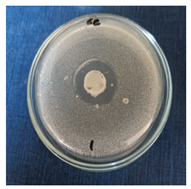 | 2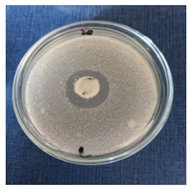 | 3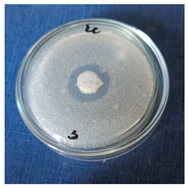 | 4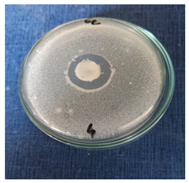 |
|---|---|---|---|---|
| Zone of inhibition (mm) | H = 10 (mm) | H = 8.5 (mm) | H = 6.5 (mm) | H = 8 (mm) |
| Sample No. | 1 | 2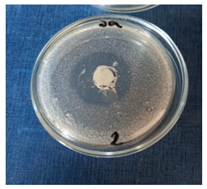 | 3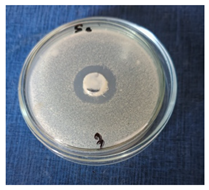 | 4 |
|---|---|---|---|---|
| Zone of inhibition (mm) | H = 11.5 (mm) | H = 13.5 (mm) | H = 8.5 (mm) | H = 9.5 (mm) |
Disclaimer/Publisher’s Note: The statements, opinions and data contained in all publications are solely those of the individual author(s) and contributor(s) and not of MDPI and/or the editor(s). MDPI and/or the editor(s) disclaim responsibility for any injury to people or property resulting from any ideas, methods, instructions or products referred to in the content. |
© 2024 by the authors. Licensee MDPI, Basel, Switzerland. This article is an open access article distributed under the terms and conditions of the Creative Commons Attribution (CC BY) license (https://creativecommons.org/licenses/by/4.0/).
Share and Cite
Dănilă, E.; Kaya, D.A.; Anuța, V.; Popa, L.; Coman, A.E.; Chelaru, C.; Constantinescu, R.R.; Dinu-Pîrvu, C.; Albu Kaya, M.G.; Ghica, M.V. Formulation and Characterization of Niacinamide and Collagen Emulsion and Its Investigation as a Potential Cosmeceutical Product. Cosmetics 2024, 11, 40. https://doi.org/10.3390/cosmetics11020040
Dănilă E, Kaya DA, Anuța V, Popa L, Coman AE, Chelaru C, Constantinescu RR, Dinu-Pîrvu C, Albu Kaya MG, Ghica MV. Formulation and Characterization of Niacinamide and Collagen Emulsion and Its Investigation as a Potential Cosmeceutical Product. Cosmetics. 2024; 11(2):40. https://doi.org/10.3390/cosmetics11020040
Chicago/Turabian StyleDănilă, Elena, Durmuș Alpaslan Kaya, Valentina Anuța, Lăcrămioara Popa, Alina Elena Coman, Ciprian Chelaru, Rodica Roxana Constantinescu, Cristina Dinu-Pîrvu, Mădălina Georgiana Albu Kaya, and Mihaela Violeta Ghica. 2024. "Formulation and Characterization of Niacinamide and Collagen Emulsion and Its Investigation as a Potential Cosmeceutical Product" Cosmetics 11, no. 2: 40. https://doi.org/10.3390/cosmetics11020040
APA StyleDănilă, E., Kaya, D. A., Anuța, V., Popa, L., Coman, A. E., Chelaru, C., Constantinescu, R. R., Dinu-Pîrvu, C., Albu Kaya, M. G., & Ghica, M. V. (2024). Formulation and Characterization of Niacinamide and Collagen Emulsion and Its Investigation as a Potential Cosmeceutical Product. Cosmetics, 11(2), 40. https://doi.org/10.3390/cosmetics11020040










